Pakistanis truly take pride in their 5,000 years old history which goes back even further into the hoary past yet untraced.
In the words of Sir Mortimer Wheeler, famed British Archaeologist, Pakistan enjoys a high international position in the history of past achievements by virtue of possessing the greatest vestiges of one of the first three mature civilizations of the world.
 To get a taste of the rich cultural
heritage of Pakistan one may visit The National Ethnographic Museum,
Lok Mela Folk Art and Craft Fair, Shah Faisal Mosque, one of Asia's
largest most impressive. While in Peshawar, a few kilometers from
the Khyber Pass, one may find a mix of Pakhtun, Afghan, and Chitral
people to name a few. The Old City has a special bazaar for every
kind of handmade crafts, brass, leather, jewellery, many from tribal
areas of the Northwest Frontier Province. Excellent ethnographic
museum and collection of Gandhara art. Possible to see Khattak dance
performance. One of the major attractions of Chitral, is the famous
Kalash valley - the home of the Kafir-Kalash or "Wearers of the
Black Robes", a primitive pagan tribe. Their ancestry is enveloped
in mystery and is the subject of controversy. A legend says that
five soldiers of the legions of Alexander of Macedonia settled in
Chitral and are the progenitors of the Kafir-Kalash.
To get a taste of the rich cultural
heritage of Pakistan one may visit The National Ethnographic Museum,
Lok Mela Folk Art and Craft Fair, Shah Faisal Mosque, one of Asia's
largest most impressive. While in Peshawar, a few kilometers from
the Khyber Pass, one may find a mix of Pakhtun, Afghan, and Chitral
people to name a few. The Old City has a special bazaar for every
kind of handmade crafts, brass, leather, jewellery, many from tribal
areas of the Northwest Frontier Province. Excellent ethnographic
museum and collection of Gandhara art. Possible to see Khattak dance
performance. One of the major attractions of Chitral, is the famous
Kalash valley - the home of the Kafir-Kalash or "Wearers of the
Black Robes", a primitive pagan tribe. Their ancestry is enveloped
in mystery and is the subject of controversy. A legend says that
five soldiers of the legions of Alexander of Macedonia settled in
Chitral and are the progenitors of the Kafir-Kalash.
 A few miles from Rawalpindi is
Takht-e-Bai, which hosts numerous Buddhist shrines dating from the
1st to 7th B.C. While in Lahore one may drive south into Punjab,
where there is the famous Rohtas Fort, a magnificent example of
military architecture, the construction of which started in the mid
- 16th Century. The old City of Lahore has artisan workshops and the
Famed Shalimar Gardens. The Sunehri Masjid (Golden Mosque) is called
so because of its three golden domes and dazzling gold plated
minarets. Here also is the museum dedicated to Mohammed Abdur Rahman
Chughtai, master artist and "reinventor" of Mughal and Persian
painting traditions. One may also pay a visit to the Lahore Fort,
which is a palace of immense proportions. The Royal Quarters have
brilliant examples of design and handicraft techniques, no longer
practiced.
A few miles from Rawalpindi is
Takht-e-Bai, which hosts numerous Buddhist shrines dating from the
1st to 7th B.C. While in Lahore one may drive south into Punjab,
where there is the famous Rohtas Fort, a magnificent example of
military architecture, the construction of which started in the mid
- 16th Century. The old City of Lahore has artisan workshops and the
Famed Shalimar Gardens. The Sunehri Masjid (Golden Mosque) is called
so because of its three golden domes and dazzling gold plated
minarets. Here also is the museum dedicated to Mohammed Abdur Rahman
Chughtai, master artist and "reinventor" of Mughal and Persian
painting traditions. One may also pay a visit to the Lahore Fort,
which is a palace of immense proportions. The Royal Quarters have
brilliant examples of design and handicraft techniques, no longer
practiced.
By heading southwest towards the Mid Indus River one may reach the culturally rich city of Multan. This town has a most distinctive structure - the shrine of Shah Rukn-iAlam. The Hussein Agahi Bazaar also has crafts traditional to this area. Across the River and south of Dera Ghazi Khan, is Choti the home of the chief of the Leghari Baluch tribe. This remarkable residence is a prime example of Mughal architecture and interior design. East of Multan is the area of Cholistan, where you may be able to meet some of nomadic people and get a glimpse of their unique dress, learn about their crafts and perhaps see the "Camel dance".
 The Bahawalpur area is famous for
its varied handicrafts. The ethnographic museum has a remarkable
collection of textiles, embroideries, jewellery and costumes from
Cholistan. Near Kot Diji is the Talpurian Fort, a huge brick
construction built on several levels, and Methelo, the abode of
Sindhi master of embroidery. Embroidery on leather can be found in
Shikarpur and Khairpur regions. You can visit the town of Thatta,
located near Karachi. It holds a site of a brick mosque with 93
domes which is another remarkable example of Mughal architecture.
This is an area of magnificent handicrafts, among them textiles with
block printing and bandhani are of great admiration. The Makli Hill
area has hundreds of tombs, with a unique construction and ornate
inscribed stonework.
The Bahawalpur area is famous for
its varied handicrafts. The ethnographic museum has a remarkable
collection of textiles, embroideries, jewellery and costumes from
Cholistan. Near Kot Diji is the Talpurian Fort, a huge brick
construction built on several levels, and Methelo, the abode of
Sindhi master of embroidery. Embroidery on leather can be found in
Shikarpur and Khairpur regions. You can visit the town of Thatta,
located near Karachi. It holds a site of a brick mosque with 93
domes which is another remarkable example of Mughal architecture.
This is an area of magnificent handicrafts, among them textiles with
block printing and bandhani are of great admiration. The Makli Hill
area has hundreds of tombs, with a unique construction and ornate
inscribed stonework.
Pakistan is a great reservoir of the heritage of the Indus, & Gandhara Civilizations. With layers of various Gandhara Kingdoms, it is unsurpassed as a treasure house of the Greco-Buddhist sculptures & artifacts. Moghul monuments are strewn all over the country.


